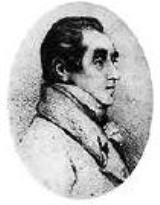
Charles Hatchett
Encyclopedia
Charles Hatchett FRS (2 January 1765 – 10 March 1847) was an English
chemist
who discovered the element niobium
.
. On 24 March 1787, he married Elizabeth Collick at St Martin's-in-the-Fields, with issue including:
Hatchett died in London and is buried at St Laurence's Church, Upton, Slough
, the same church where William Herschel
is interred.
In 1801 while working for the British Museum
in London, Hatchett analyzed a piece of columbite
in the museum's collection. Columbite turned out to be a very complex mineral
, and Hachett discovered that it contained a "new earth" which implied the existence of a new element. Hatchett called this new element columbium (Cb). On 26 November of that year he announced his discovery before the Royal Society
. The element was later rediscovered and renamed niobium (its current name).
Later in life, Hatchett quit his job as a chemist to work full time in his family's coach fabrication business.
Since 1979, the Institute of Materials, Minerals and Mining ("IOM3") (London) has given the Charles Hatchett Award yearly to a noted metallurgist. The award is given to the "author of the best paper on the science and technology of niobium and its alloys."
United Kingdom
The United Kingdom of Great Britain and Northern IrelandIn the United Kingdom and Dependencies, other languages have been officially recognised as legitimate autochthonous languages under the European Charter for Regional or Minority Languages...
chemist
Chemist
A chemist is a scientist trained in the study of chemistry. Chemists study the composition of matter and its properties such as density and acidity. Chemists carefully describe the properties they study in terms of quantities, with detail on the level of molecules and their component atoms...
who discovered the element niobium
Niobium
Niobium or columbium , is a chemical element with the symbol Nb and atomic number 41. It's a soft, grey, ductile transition metal, which is often found in the pyrochlore mineral, the main commercial source for niobium, and columbite...
.
Biography
Hatchett was born, raised, and lived in LondonLondon
London is the capital city of :England and the :United Kingdom, the largest metropolitan area in the United Kingdom, and the largest urban zone in the European Union by most measures. Located on the River Thames, London has been a major settlement for two millennia, its history going back to its...
. On 24 March 1787, he married Elizabeth Collick at St Martin's-in-the-Fields, with issue including:
- John Charles Hatchett (bapt 27 January 1788 St Martin's-in-the-Fields)
- Anna Hatchett, who married William Brande
Hatchett died in London and is buried at St Laurence's Church, Upton, Slough
St Laurence's Church, Slough
Saint Laurence's Church is one of three churches in the modern parish of Upton-cum-Chalvey, and is the oldest building in the borough of Slough, in Berkshire, England....
, the same church where William Herschel
William Herschel
Sir Frederick William Herschel, KH, FRS, German: Friedrich Wilhelm Herschel was a German-born British astronomer, technical expert, and composer. Born in Hanover, Wilhelm first followed his father into the Military Band of Hanover, but emigrated to Britain at age 19...
is interred.
In 1801 while working for the British Museum
British Museum
The British Museum is a museum of human history and culture in London. Its collections, which number more than seven million objects, are amongst the largest and most comprehensive in the world and originate from all continents, illustrating and documenting the story of human culture from its...
in London, Hatchett analyzed a piece of columbite
Columbite
Columbite, also called niobite, niobite-tantalite and columbate [2O6], is a black mineral group that is an ore of niobium and tantalum. It has a submetallic luster and a high density and is a niobate of iron and manganese, containing tantalate of iron. This mineral group was first found in Haddam,...
in the museum's collection. Columbite turned out to be a very complex mineral
Mineral
A mineral is a naturally occurring solid chemical substance formed through biogeochemical processes, having characteristic chemical composition, highly ordered atomic structure, and specific physical properties. By comparison, a rock is an aggregate of minerals and/or mineraloids and does not...
, and Hachett discovered that it contained a "new earth" which implied the existence of a new element. Hatchett called this new element columbium (Cb). On 26 November of that year he announced his discovery before the Royal Society
Royal Society
The Royal Society of London for Improving Natural Knowledge, known simply as the Royal Society, is a learned society for science, and is possibly the oldest such society in existence. Founded in November 1660, it was granted a Royal Charter by King Charles II as the "Royal Society of London"...
. The element was later rediscovered and renamed niobium (its current name).
Later in life, Hatchett quit his job as a chemist to work full time in his family's coach fabrication business.
Since 1979, the Institute of Materials, Minerals and Mining ("IOM3") (London) has given the Charles Hatchett Award yearly to a noted metallurgist. The award is given to the "author of the best paper on the science and technology of niobium and its alloys."

